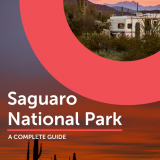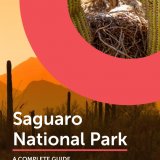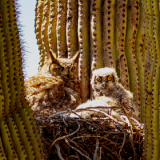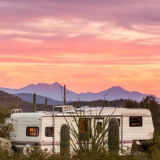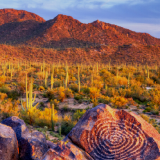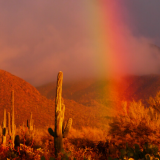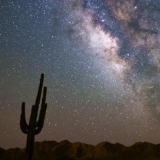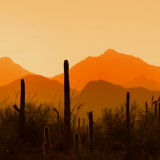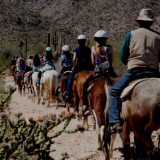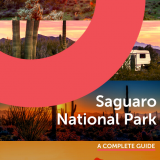“Do whatever you want” – the Saguaro cactus. Pronounced “suh·waa·row,” these tree-like blossoming desert cacti are kind of hard to define. They can live 200 years. They can grow up to 49 arms. But there’s no pressure, so some of them don’t grow any arms at all. Some Saguaros spend 10 years growing only two inches. Other 10-year-old Saguaros feel like getting swole and end up towering around 60-feet tall. The Saguaro is one of the most creative cacti on the planet, and to thank them for their beauty, we gave them their very own spot: Saguaro National Park. This unique US National Park located in the southwest, and just so happens to be our favorite Arizona national park. The only rule here? No touching.
Where is Saguaro National Park?

Located both to the east and west of Tucson, Saguaro National Park is an iconic experience in the American Southwest. The Saguaro cactus, native to this region, is predominantly found in the dry southern part Arizona, spilling over into the Mexican state of Sonora and Imperial County, California. Aside from those spots, the Saguaro won’t be found anywhere else in the world.
Driving from Phoenix to Saguaro National Park

From Phoenix, your trip will cover about 100 miles and should take around an hour and a half, depending on traffic. Take I-10E to Avra Valley Road, exit 242. Then drive 6 miles west to Sandario Road. Turn left, and drive 14 miles on Sandario Road. Turn left onto Kinney Road. Red Hills Visitor Center is on your left in 2 miles.
Weather in Saguaro National Park
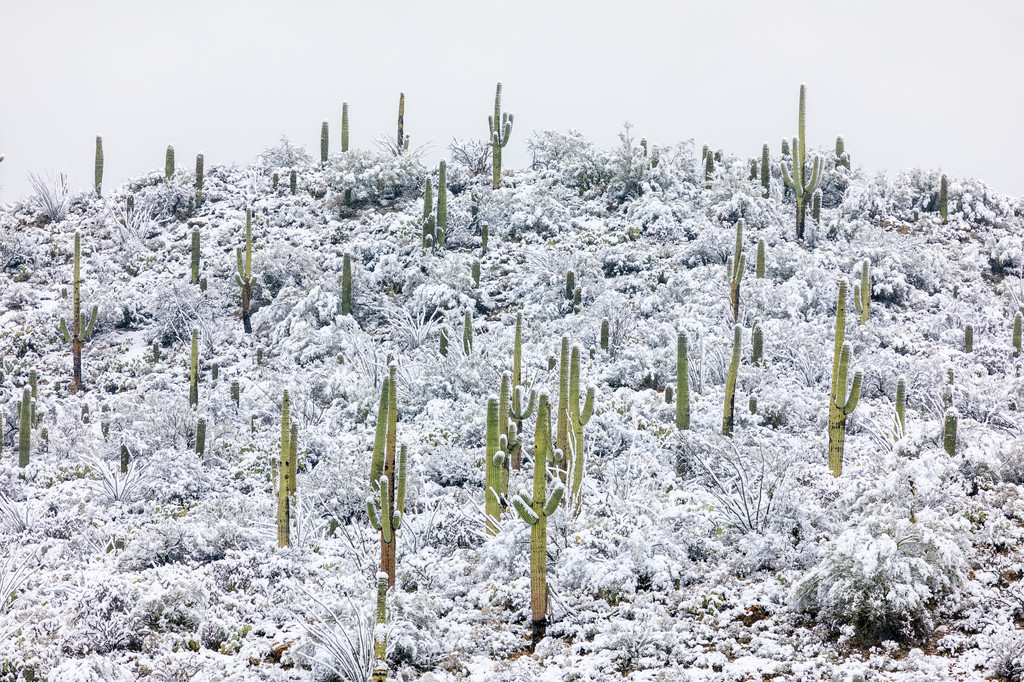
November through March is the high season for Saguaro National Park thanks to the moderate temperatures and occasional surprise snowfall. April, however, sees relatively moderate temperatures and while the crowds have died down, the Saguaro cactuses begin to bloom. With their stunning white flowers, Saguaros in bloom are certainly a sight to see. The local bee and bird populations will agree. If you visit in the summer months, be prepared for temperatures reaching above 110℉ and be prepared with proper sun protection and plenty of water.
Hours of Operation

Saguaro National Park is open year-round. The Tucson Mountain District (west) is open sunrise to sunset daily for vehicles, and open to foot and bike traffic 24 hours a day, 356 days a year. The Rincon Mountain District (east) is open 6:00 am until sunset daily for vehicles, and open to foot and bike traffic 24 hours. The Red Hills Visitor Center is open 9am -5pm daily except December 25th. Check the park’s website for up to date hours and notices. Saguaro National Park is under limited operations due to COVID-19. For current status and frequent updates, check out Saguaro’s current conditions.
Entrance Fee

You’ll need to purchase a pass to enter Saguaro National Park. A 7-day pass for one car plus all passengers is $25. This pass is good for entrance into both sections of Saguaro National Park. If you plan on visiting a few National Parks this year, the best deal for most people is the Interagency Annual Pass, affectionately called the America the Beautiful pass. This allows unlimited access to all Federal fee areas for one year from the date of purchase. The standard fee for this is $80, but is discounted for seniors and free for active duty military, those with disabilities, and kids in the 4th grade.
Saguaro National Park Facts
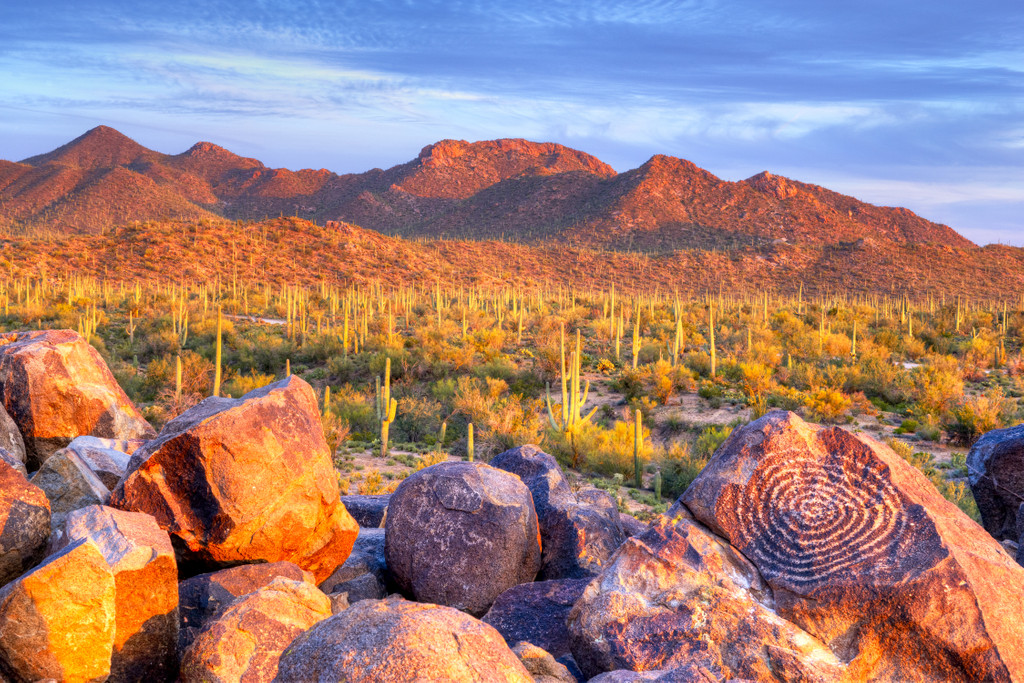
Saugaro National Park encompasses two separate sections: the Saguaro National Park West (Tucson Mountain District) and Saguaro National Park East (Rincon Mountain District). Together, the area covers 91,716 acres with 165 miles of trails. Traveling between the two sections of the park takes 30-45 minutes depending on traffic. Estimates calculate that roughly 1.8 million Saguaros grow within the park’s borders. There’s even a Saguaro census that takes place every ten years to keep this number accurate. Seeing a bit over 1 million visitors annually, the park is much younger than its namesake resident cacti, only becoming a national park on October 14, 1994.
Trails In and Around Saguaro National Park

In Saguaro, skies are clear and trails are plentiful. If you’re ready to stretch your legs (but not sure where to start), here’s a list of 10 of our favorite hiking trails in Saguaro National Park:
- Freeman Homestead Trail
- Garwood Dam and Wildhorse Tank
- Loma Verde Loop
- Hope Camp and Ridgeview Trail
- Tanque Verde Ridge Trail
- Sendero Esperanza Trail to the Ridge
- King Canyon / Gould Mine Loop
- Sendero Esperanza Trail to Wasson Peak
- Wild Dog Trail
- Cactus Garden strolls at either visitor center
Lodging in Saguaro National Park
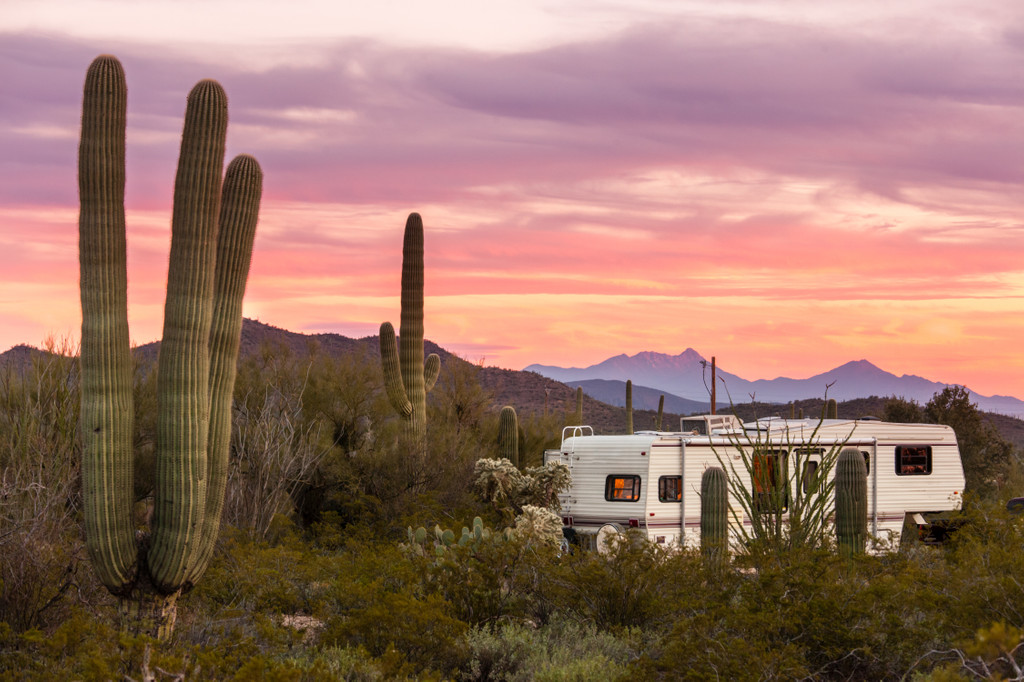
Camping Near Saguaro National Park
Planning a night under the stars? Here are some of the best campgrounds and campsites inside and outside of Saguaro National Park:
- Happy Valley Saddle (in the park)
- Manning Camp (in the park)
- Grass Shack (in the park)
- Spud Rock Spring (in the park)
- Juniper Basin (in the park)
- Douglas Spring (in the park)
- Gilbert Ray Campground
- Tucson Mountain Park
- Justin’s Diamond J RV Park
- Tucson / Lazydays KOA Resort
Hotels Near Saguaro National Park
If camping isn’t your thing, there are plenty of resorts, hotels, hostels, inns, cabins and B&Bs within a quick drive of Saguaro National Park. Here are some of our favorites:
- White Stallion Ranch
- Crickethead Inn Bed & Breakfast
- Casino Del Sol
- Omni Tucson National Resort
- Hotel McCoy
- Casa Tierra Adobe Bed & Breakfast
- Hacienda Linda Bed & Breakfast
Saguaro National Park Airbnb
Since the park is located on both sizes of metropolitan Tucson, the area is overflowing with Airbnb options.. To capitalize on the desert experience, stay at the Central and Stylish Midcentury Pool House. Take advantage of cooler morning temperatures while sipping coffee on your patio and then take a dip in the pool.
The Cowboy Hideaway is also an irresistible option. A swimming pool with a slide and a putting green are here for your enjoyment but the real attraction are the mini donkeys, goats and rescue horses you get to hang out with. The accommodations are exquisite as well. Sorry in advance if you want to buy a ranch after staying here.
Saguaro National Park Tours

Ranger programs are available year round in Saguaro National Park, but the January through April high-season offers the largest availability and selection. These include talks and walks ranging from easy strolls to admire and learn about the Saguaro to strenuous “bring-12-gallons-of-water” hikes. The low summer season sees a limited number of park tours that don’t happen everyday. Check the calendar for current offerings before you go.
Saguaro National Park Bucket List
Take a Selfie with a Cactus on the Desert Discovery Nature Trail
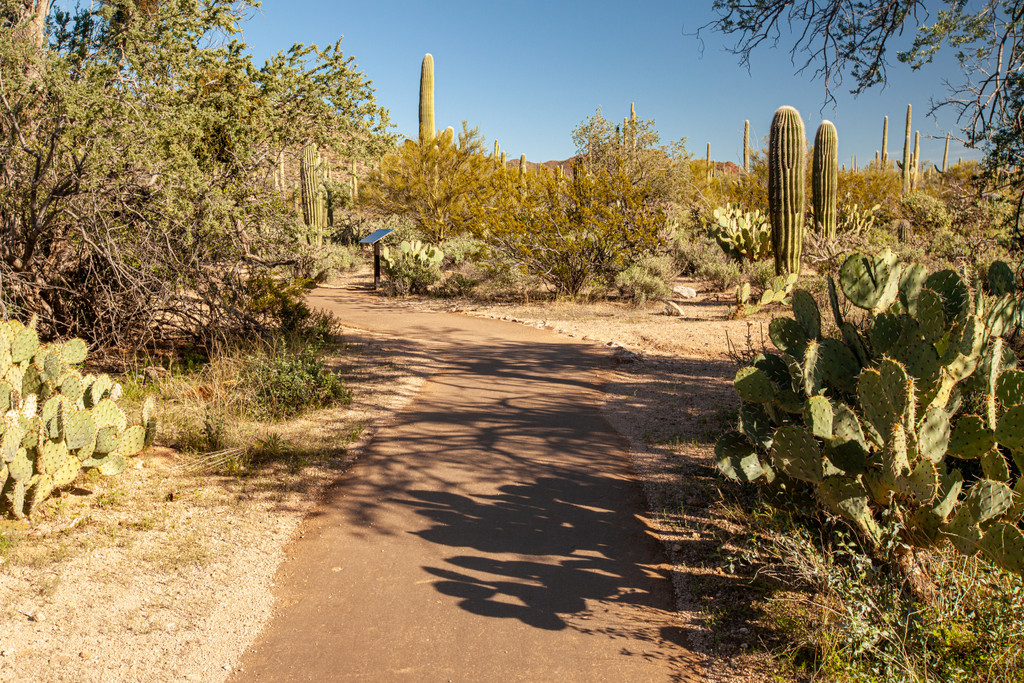
This paved and totally level loop hike is only half a mile long. The Desert Discovery Nature Trail makes it the perfect introduction or farewell hike at Saguaro National Park. Suitable for all abilities and ages. PS: this is a great place to take some selfies with the Saguaro.
Find All the Flora & Fauna on a Ranger-Led Park Tour

At first glance, the desert of Saguaro National Park looks and feels inhospitable. How could anything survive without water and in such high temperatures? But the desert is home to some of the most adaptive and interesting plants and animals on our planet. Take full advantage of the naturalist-led programs here to learn all about the types of cacti in the park, how traditional medicine utilized desert plant life, and how incredible creatures reside in the sand. Despite its name, you’ll soon realize the Gila Monster is actually adorable.
Catch an Iconic Saguaro Sunset
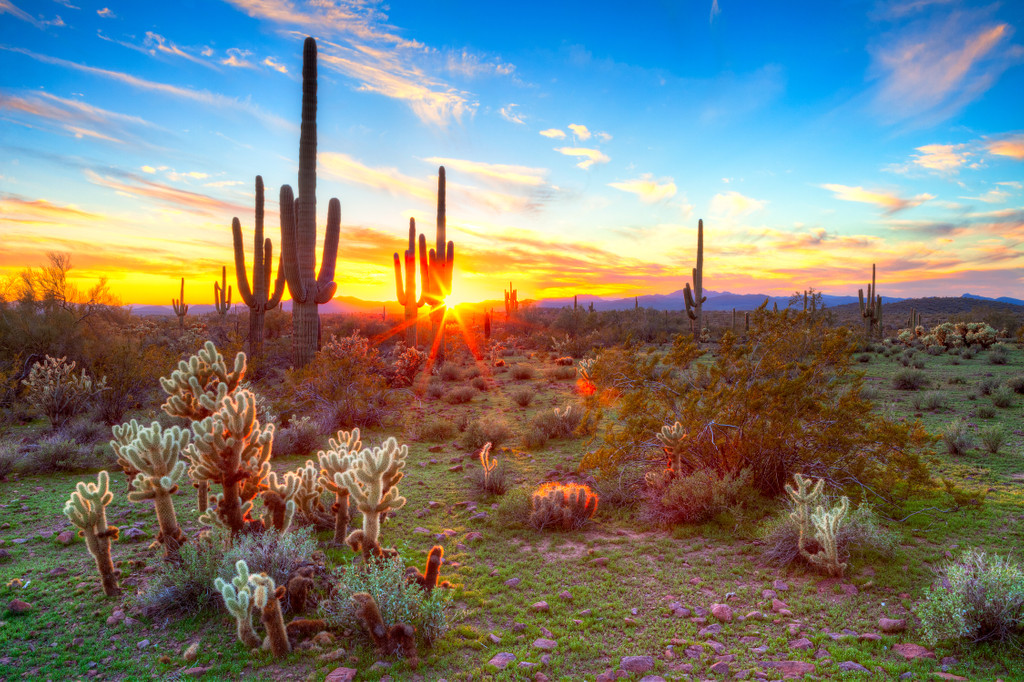
It’s mandatory that you take 809 pictures of sunset with silhouetted Saguaro cactuses to fill your social feeds with. The best spot to catch sunset at the park is on the east side at either the Tanque Verde Ridge Trail (.5 mile hike) or the Javelina Rocks pull out.
More Things to Do in Saguaro National Park
Hop on a Mountain Bike

Marvel at Petroglyphs on the Signal Hill Trail

Bicycle the Cactus Forest Loop Drive in the Rincon Mountain District

Take Part in the Gila Monster Project

Catch Sunset for Epic Pictures in Saguaro National Park

Go Horseback Riding in the Cactus Forest

Take an Air-Conditioned Drive on the Scenic Bajada Loop

Walk in the Dark During the Two-Hour Ranger-Led Night Hike
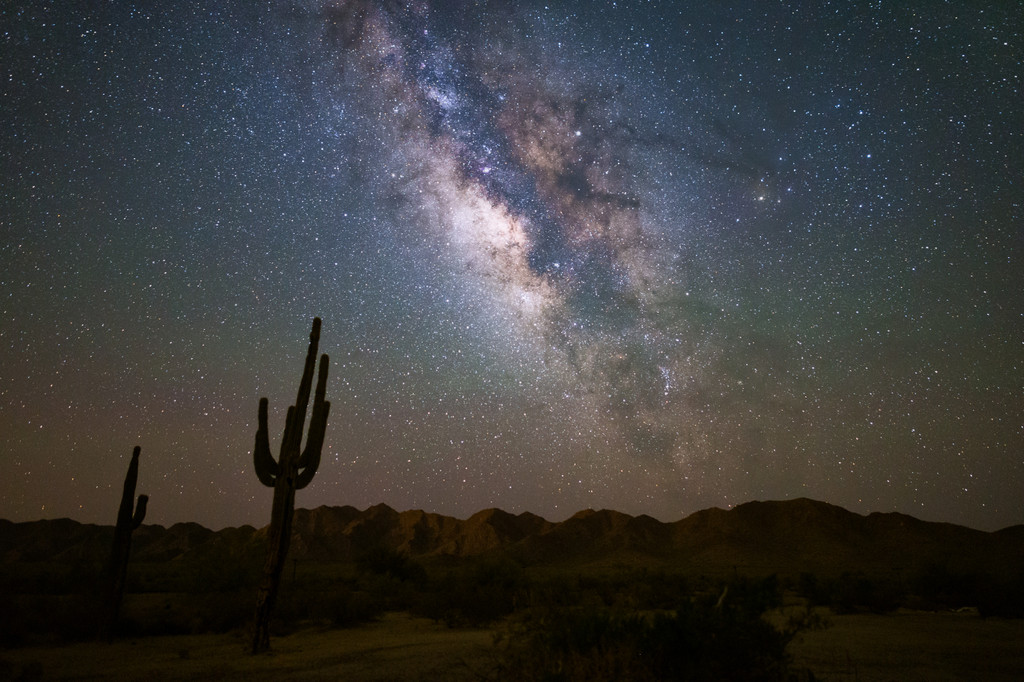
Visit in April through June to Catch the Saguaros in Bloom

